Utah is characterized by its rugged mountains, arid deserts, and the iconic Great Salt Lake. From the majestic peaks of the Wasatch Range to the serene landscapes of the Great Salt Lake, Utah’s diverse ecosystems are home to a colorful array of avian wonders.
Dive into our guide to discover the 9 radiant orange birds that grace the Utah skies and learn how to best capture their beauty with our free photo guide.
Orange Birds Found In Utah
The distinct ecosystems, with its own set of flora and fauna, serve as ideal homes for a myriad of bird species. The presence of the Great Salt Lake acts as a magnet for migratory birds, providing essential nesting and feeding grounds. Additionally, the state’s position along the Pacific Flyway migration route ensures a constant influx of diverse bird species throughout the year, enriching the local avifauna and making Utah a birdwatcher’s paradise.
Barn Swallow

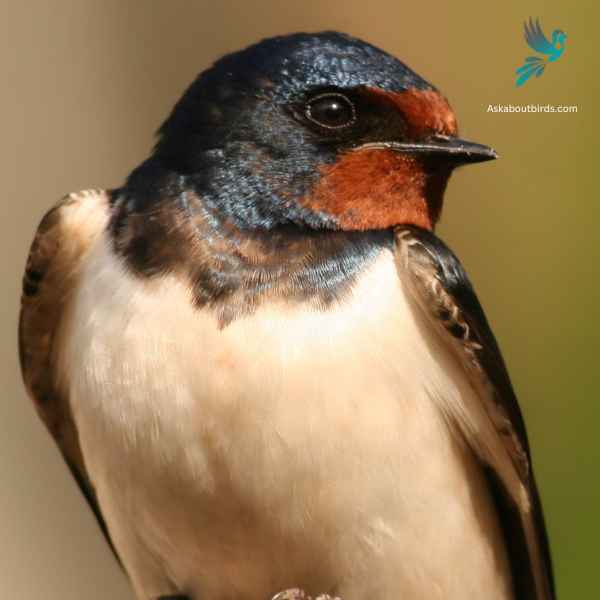
| Feature | Measurement |
|---|---|
| Scientific Name | Hirundo rustica |
| Length | 6.5–7.5 in |
| Wingspan | 12.5–13.5 in |
| Weight | 16–22 g |
The Barn Swallow is a sleek, agile bird renowned for its graceful flight patterns and iconic forked tail, often seen darting over fields and water bodies in search of flying insects.
Appearance: Barn Swallows have deep blue, almost iridescent, upperparts and a rufous to tawny underbelly. Their distinctively forked tail and long wings give them a streamlined look. Both males and females have a similar appearance, though males often exhibit slightly brighter colors and a deeper fork in the tail.
Diet: Barn Swallows feed primarily on flying insects, which they catch in mid-air during their agile and acrobatic flights. Their diet includes flies, beetles, moths, and other small flying insects.
Reproduction: Barn Swallows are known for building their mud nests on man-made structures, particularly barns, bridges, and eaves. The nest is cup-shaped and made from mud pellets, often lined with feathers. The female lays a clutch of 4 to 6 eggs.
American Robins


| Feature | Measurement |
|---|---|
| Scientific Name | Leptotila plumbeicep |
| Length | 10.6-11.8 in |
| Wingspan | — |
| Weight | 160-200 g |
The American Robin is a widely recognized bird species known for its melodious song and early bird tendencies.
Appearance: American Robins are medium-sized birds with a distinctive appearance. Both males and females sport a gray to brown back and a warm red to orange breast and belly and gray wings. They also have a characteristic white eye-ring and a black head, but males are usually darker than females.
Diet: American Robins have a diverse diet that changes depending on the season. In summer, they feed heavily on earthworms, beetles, and other invertebrates, which they catch on the ground. During winter, they mostly eat fruits and berries.
Reproduction: American Robins usually build their nests in trees or shrubs, but they are also known to nest on human-made structures. The female lays a clutch of about 3 to 5 eggs, which she incubates for about 12 to 14 days.
Western Tanager

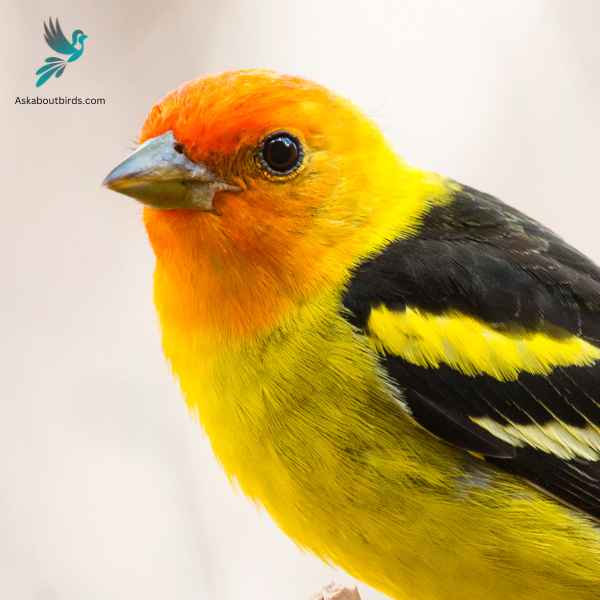
| Feature | Measurement |
|---|---|
| Scientific Name | Piranga ludoviciana |
| Length | 6.3-7.5 in |
| Wingspan | 11.5 in |
| Weight | 24-36 g |
The Western Tanager is a vibrant songbird that graces the forests and woodlands of the western regions of North America, enchanting observers with its colorful plumage and melodious song.
Appearance: The male Western Tanager is renowned for its bright yellow body contrasted with a striking red head and black wings and tail. The females are more subdued in hue, primarily being yellow with grayish wings and back, and lacking the brilliant red head of the males.
Diet: Western Tanagers primarily feed on insects, especially when breeding, but they also incorporate a significant amount of fruits and berries into their diet, especially during migration and winter.
Reproduction: Western Tanagers build their nests high in coniferous trees, often well concealed from potential predators. The female usually lays a clutch of 3 to 5 eggs and takes the primary role in incubation, while both parents are involved in feeding the chicks after they hatch.
Black-headed Grosbeak

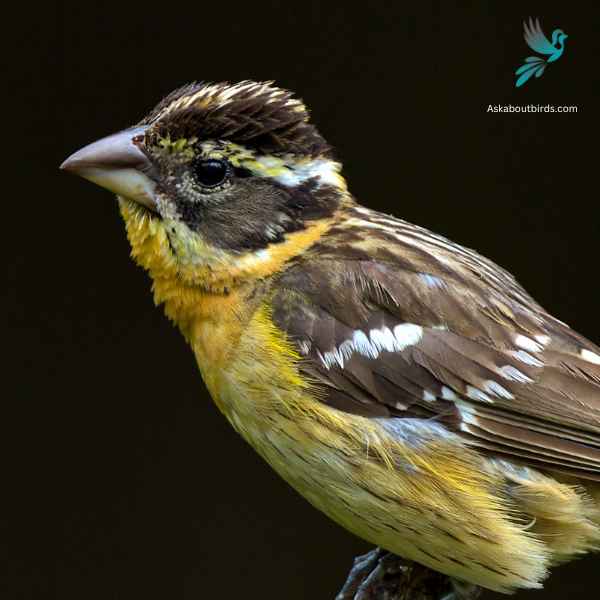
| Feature | Measurement |
|---|---|
| Scientific Name | Pheucticus melanocephalus |
| Length | 7.1–7.5 in |
| Wingspan | 12.6 in |
| Weight | 34–48 g |
The Black-headed Grosbeak is a vibrant songbird known for its melodious song, often confused with that of the American Robin but more rich and varied.
Appearance: Males are recognizable by their orange chest, black head, and black and white wings. Females, on the other hand, have a streaked brown appearance, resembling large sparrows but with hints of orange on their sides and flanks.
Diet: Black-headed Grosbeaks primarily feed on insects, seeds, and fruits. They are especially fond of beetles and caterpillars, and they’re one of the few birds that can eat monarch butterflies without suffering from the toxins.
Reproduction: They often nest in deciduous trees or shrubs. The nest is a loose, cup-like structure made from twigs and grasses. The female usually lays 3 to 4 eggs, which she incubates. Both parents share the responsibility of feeding the chicks.
Spotted Towhee

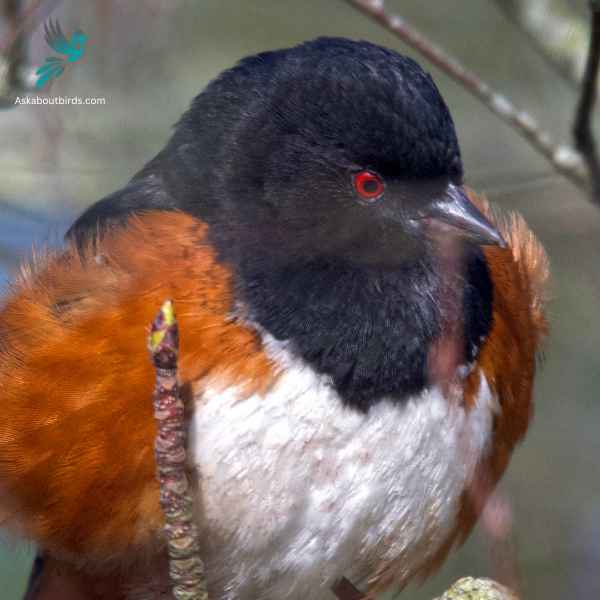
| Feature | Measurement |
|---|---|
| Scientific Name | Pipilo maculatus |
| Length | 6.7-8.3 in |
| Wingspan | 11.0 in |
| Weight | 33 g |
The Spotted Towhee is a distinctive songbird commonly found in the shrubby undergrowth and thickets of the western parts of North America. Its song, a series of melodious chirps, often punctuates the early morning air.
Appearance: Male Spotted Towhees showcase a coal-black head, throat, and upper body contrasted with rufous sides and a white belly. Their wings and back are dark but adorned with white spots, hence their name. Females have a similar pattern but are more brownish than black.
Diet: Spotted Towhees primarily feed on a mixture of insects and seeds. They often forage on the ground, scratching through leaf litter to uncover beetles, ants, and other insects, as well as various seeds and berries.
Reproduction: Spotted Towhees usually nest on the ground, concealed by dense vegetation or sometimes in low shrubs. The female builds the nest and lays a clutch of 3 to 5 eggs. She incubates the eggs, while the male stands guard and both parents partake in feeding the fledglings after hatching.
Red-breasted Nuthatch

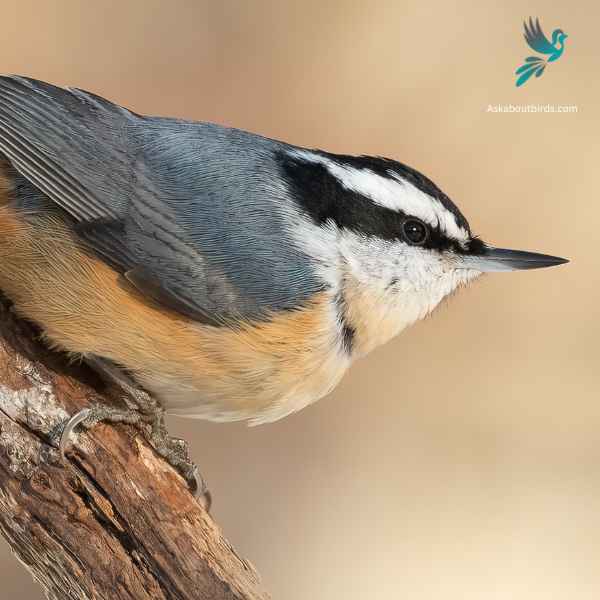
| Feature | Measurement |
|---|---|
| Scientific Name | Sitta canadensis |
| Length | 4.3–4.7 in |
| Wingspan | 8.3 in |
| Weight | 0.3–0.5 oz |
The Red-breasted Nuthatch is a small, agile songbird, known for its ability to move headfirst down tree trunks while searching for food.
Appearance: This bird boasts a slate-blue back and a pale rust-red underside. A prominent black stripe runs through the eye and is bordered above by a white eyebrow. Their sharp, pointed bill is characteristic of the species.
Diet: Red-breasted Nuthatches primarily feed on insects and seeds, especially those from coniferous trees. They have a fondness for large seeds, which they wedge into bark crevices to hack open with their bills.
Reproduction: These birds construct nests in natural tree cavities or abandoned woodpecker holes, often lining the entrance with resin. This is thought to deter predators or competitors from entering. The female typically lays a clutch of 5 to 6 eggs, and both parents partake in feeding the chicks once they hatch.
Bullock’s Oriole

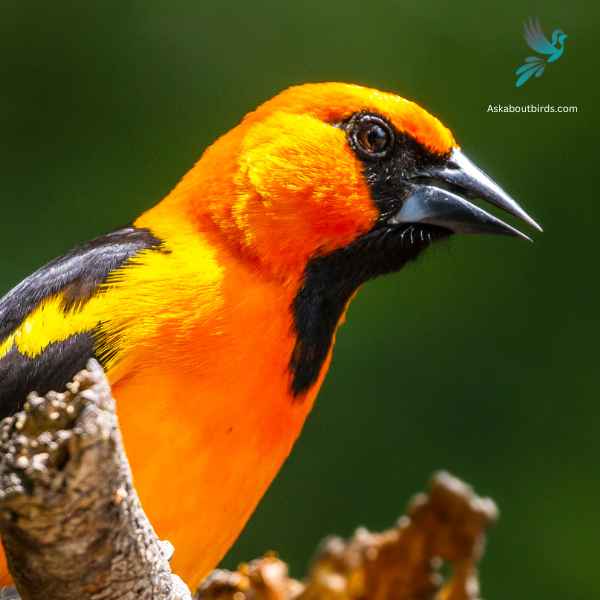
| Feature | Measurement (Imperial) |
|---|---|
| Scientific Name | Icterus bullockii |
| Length | 7.5-8.5 inches |
| Wingspan | 11.8-12.6 inches |
| Weight | 0.9-1.2 oz |
The Bullock’s Oriole is a bright and lively songbird, known for its stunning contrasting colors and vibrant melodies, predominantly found across the western regions of North America.
Appearance: The male Bullock’s Oriole boasts a brilliant orange chest, belly, and face with a black crown, eye line, throat, and back. Its wings are black with a prominent white patch and white-edged coverts. Females are more muted in coloration, displaying a yellowish-orange hue with grayish-brown wings that still retain the white patches.
Diet: These orioles primarily feed on insects, especially caterpillars, beetles, and grasshoppers. Apart from insects, their diet also includes fruits, berries, and nectar. They’re adept foragers, often hanging upside-down on branches to find hidden prey.
Reproduction: Bullock’s Orioles are noted for their skill in crafting hanging, woven nests, often positioned on the tips of slender branches, ensuring they are difficult for predators to access. Both parents partake in feeding the young, who then fledge about two weeks after hatching.
American Redstart


| Feature | Measurement |
|---|---|
| Scientific Name | Setophaga ruticilla |
| Length | 4.3 to 5.5 in |
| Wingspan | 6.3 to 9.1 in |
| Weight | 8.6 g |
The American Redstart is a lively warbler known for its vivid colors and active hunting style, often seen flitting about, fanning its tail to startle and catch insects.
Appearance: Adult male American Redstarts boast striking black plumage with bright orange patches on the sides, wings, and tail. Females and immature males have grayish-olive upperparts with yellow patches in the same areas where the males display orange.
Diet: American Redstarts are primarily insectivores. They actively forage for flying insects, as well as caterpillars and spiders, often using their colorful tails to startle prey and make them easier to catch.
Reproduction: The female American Redstart builds a cup-shaped nest in the fork of a tree branch. Typically, she lays a clutch of 3 to 5 eggs. The female takes on the primary responsibility of incubating the eggs, while both parents participate in feeding the fledglings after they hatch.
Rufous Hummingbird


| Feature | Measurement |
|---|---|
| Scientific Name | Selasphorus rufus |
| Length | 3.1–3.9 in |
| Wingspan | 4.3 in |
| Weight | 0.1–0.2 oz |
The Rufous Hummingbird is a small, brilliantly colored bird known for its impressive migratory journeys and feisty behavior.
Appearance: The male Rufous Hummingbird boasts a gleaming orange-red body with a white chest and an iridescent red throat, called a gorget. The female has green upperparts with rufous-washed flanks and tail. Her throat may have some iridescent patches, but it’s generally whitish.
Diet: Like other hummingbirds, the Rufous Hummingbird primarily feeds on nectar from a variety of flowering plants. They also eat insects and spiders for protein, catching them in flight or plucking them from vegetation.
Reproduction: Rufous Hummingbirds nest in trees, shrubs, or even ferns. The female alone selects the site, builds the nest, and cares for the offspring.
Northern Flicker

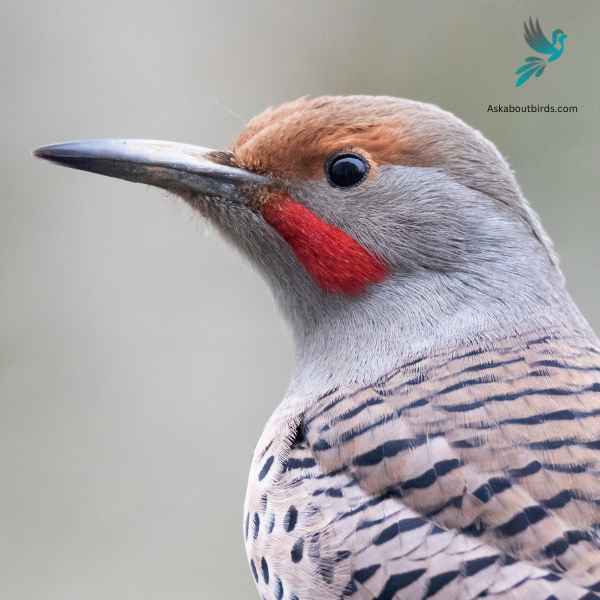
| Feature | Measurement |
|---|---|
| Scientific Name | Colaptes auratus |
| Length | 11–12 in |
| Wingspan | 17–20 in |
| Weight | 3.9–5.6 oz |
The Northern Flicker is a medium-sized woodpecker, recognized by its unique patterns and coloring, often found drumming on trees or foraging on the ground across North America.
Appearance: The Northern Flicker stands out with its grayish brown body, black-scalloped plumage, and a black bib. Males sport a distinctive black or red mustache stripe. Depending on the subspecies, the underwing and undertail feathers can be bright yellow or red, flashing vividly during flight.
Diet: While most woodpeckers are tree-bark foragers, the Northern Flicker prefers hunting on the ground. Its primary diet consists of ants and beetles, supplemented occasionally by fruits, berries, seeds, and other small insects.
Reproduction: Northern Flickers are cavity nesters, preferring to excavate their nesting hole in dead or diseased tree trunks. The interior of the nest is lined with wood chips.
House Finch


| Feature | Measurement |
|---|---|
| Scientific Name | Haemorhous mexicanus |
| Length | 5–6 in |
| Wingspan | 8–10 in |
| Weight | 0.6–0.9 oz |
The House Finch is a small songbird widely distributed across North America and is commonly found in urban and suburban areas.
Appearance: Males of this species are brightly colored with crimson faces and throats, which can extend to the chest and back, while their flanks have streaks. The female is streaked brown and lacks the red coloring. Both have a square-tipped tail and a distinctively long, flat-topped bill.
Diet: House Finches primarily eat seeds, grains, and berries. They have a particular fondness for sunflower seeds and can be commonly seen at bird feeders. Occasionally, they will also consume insects, especially during the breeding season.
Reproduction: House Finches are cavity-nesters and might choose ledges, vents, ledges, and other urban settings. They might also utilize trees or shrubs. Their nests can be made of a wide array of materials, from feathers to twigs.
Vermilion Flycatcher
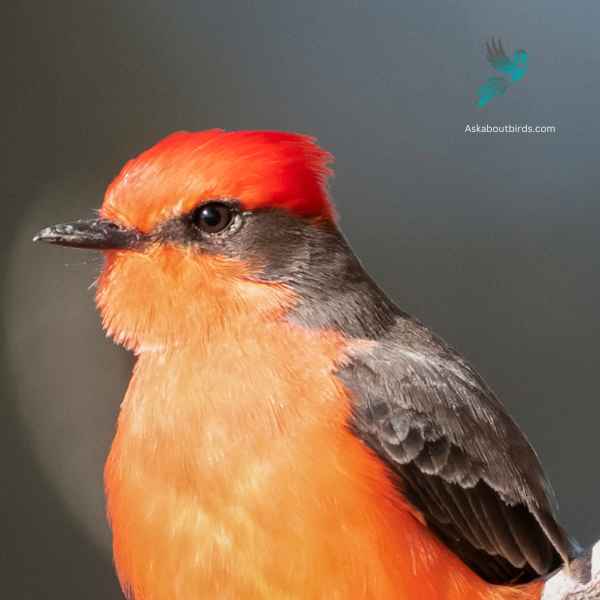

| Feature | Measurement |
|---|---|
| Scientific Name | Pyrocephalus obscurus |
| Length | 5.1–5.5 in |
| Wingspan | 9.4 to 9.8 in |
| Weight | 11 to 14 g |
The Vermilion Flycatcher is a small and colorful bird native to the Americas. The male Vermilion Flycatcher is a striking sight, displaying a vibrant red plumage on its head, breast, and underparts, contrasting with its brown wings and black tail below. Females, on the other hand, have more muted colors, featuring a pale yellowish belly and grayish-brown upperparts.
Vermilion Flycatchers are known for their lively and acrobatic flight displays, which they perform during courtship or to defend their territories. They often sing a series of soft, whistled notes while engaged in these aerial displays. They construct cup-shaped nests, usually in shrubs or low trees, where females lay their eggs and raise their young.
Where to Spot Utah’s Orange Birds
From alpine meadows to desert canyons, Utah’s diverse ecosystems are a haven for bird enthusiasts. Here are the top spots to witness the state’s orange-feathered wonders.
- Great Salt Lake: As one of the Western Hemisphere’s most important habitats for migratory birds, the lake’s marshes attract thousands of birds, offering both seasonal and resident species.
- Bryce Canyon National Park: Beyond its iconic red rock hoodoos, Bryce provides a unique high-altitude environment where various bird species, including those with vivid orange plumage, thrive.
- Bear River Migratory Bird Refuge: Nestled in the northeastern arm of the Great Salt Lake, this refuge boasts a mix of upland and marshy habitats, drawing a rich diversity of birdlife.
- Zion National Park: The varied terrain from low riverbanks to high cliffs ensures a mosaic of habitats, making it an excellent place for birding throughout the year.
- Red Cliffs Desert Reserve: Situated near St. George, this reserve’s desert environment offers a unique backdrop for spotting various bird species, including those with striking orange hues.
| State’s Orange Birds | Best Spots for Orange Birds |
|---|---|
| Arizona’s Orange Birds | 1. Grand Canyon National Park 2. Saguaro National Park 3. Huachuca Mountains |
| Colorado’s Orange Birds | 1. Rocky Mountain National Park 2. Pawnee National Grassland 3. San Juan National Forest |
| Idaho’s Orange Birds | 1. Coeur d’Alene Lake 2. Sawtooth National Forest 3. Bear Lake |
| Nevada’s Orange Birds | 1. Great Basin National Park 2. Ruby Mountains 3. Ash Meadows National Wildlife Refuge |
| New Mexico’s Orange Birds | 1. Gila National Forest 2. Bosque del Apache National Wildlife Refuge 3. Carlsbad Caverns National Park |
| Wyoming’s Orange Birds | 1. Yellowstone National Park 2. Grand Teton National Park 3. Bighorn National Forest |
FAQs on Orange Bird Species Found in Utah
What are the beautiful orange birds called?
One of the most recognized beautiful orange birds is the Baltimore Oriole. Males are particularly striking with their vivid orange and black coloration. Another notable bird with orange hues is the Scarlet Tanager, which has a bright red-orange body contrasted by black wings.
What bird is orange and brown in Utah?
In Utah, the Rufous Hummingbird is a bird that exhibits a combination of orange and brown and visit bird feeders (nectar feeders). Male Rufous Hummingbirds are especially vibrant, showcasing bright orange or “rufous” feathers on their back and flanks, while some parts of their body, especially the tail, can appear more brownish. Another consideration is the Spotted Towhee, which, although not entirely orange, has a rufous-orange flanked side contrasting its brown upper parts and white belly.
Utah, with its diverse landscapes ranging from arid deserts to snowy peaks, is a treasure trove for bird enthusiasts. Among its avian inhabitants, yellow birds, such as the American Goldfinch with its vibrant hue, are a frequent sight. These birds often visit backyard feeders, much to the delight of homeowners who get to observe their intricate tail feathers and delightful antics up close.
Another captivating feature to watch for is the white wing bars on certain species, a stark contrast against their otherwise colorful plumage. In addition to the yellows, the hues of rusty orange make a striking appearance in the Utah avian scene, with birds like the Rufous-sided Towhee showcasing this vibrant color.
To ensure a regular avian audience, many Utah residents set up bird feeders, providing nourishing treats that attract a plethora of species. Whether you’re in the heart of Salt Lake City or the outskirts of Moab, the state promises birdwatching experiences that captivate and inspire.





